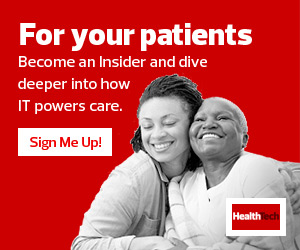HEALTHTECH: Companies are driving consumerization in healthcare. How is that trend impacting traditional healthcare organizations, and why do you think it's important for them to be agile in response?
LU: There are a lot of disruptors out there, from big tech and other industries, trying to get into healthcare. In a way, it’s interesting to see the potential and the possibilities created by that. Because they have funding, they can apply innovative technology without the tether of foundational technical debt that needs to be considered. Also, because they’re not in healthcare itself, they aren’t weighed down by having to understand the complexity of care coordination, payer models or even security and data. They can think outside the box. They don’t have a lot of the foundational knowledge that may tether and hinder possibilities in traditional healthcare.
Traditional providers must be watching what is happening and whether that disruption becomes reality. It may push healthcare toward easier access or simpler coordination, which might really disrupt the payer model and mix in the provider space. Margins and reimbursements in the provider space are already challenging, so this will be another area that would need to be considered.
Healthcare providers need to be agile to leverage their high acuity healthcare knowledge and subject matter expertise while also leveraging all the goodness that the disruptors are exemplifying. The includes utilizing digital to make things simpler and easier and to create a more joyful experience for care coordination and the individual.
HEALTHTECH: When it comes to achieving digital transformation in healthcare today, what are some of the common barriers that healthcare organizations may come up against?
LU: The common barriers to digital transformation for traditional healthcare providers are their foundational technical debt, the culture and funding. I think they can be overcome, but those are the biggest barriers.
EXPLORE: Northwell Health strengthened seamless communication for better clinical collaboration.
HEALTHTECH: How do you balance different patient priorities and levels of technology engagement as you work toward digital transformation?
LU: People tend to go after digital transformation thinking that every person and persona desires to be engaged digitally. However, healthcare is not travel or shopping. It is a very personalized engagement and interaction. Sometimes, it happens during the darkest and hardest times for individuals or families, when they’re engaging in crisis mode. As you begin your digital transformation, you really need to think about multichannel engagement and meeting the consumer — or, I would say, the caregiver or family — where they are, in the most optimal way for them throughout the journey. It’s not one and done.
Someone may want to use the web to look up and access specialties or engage a provider, but then once they do their background research, they may want to pick up the phone and talk to that individual to understand how they practice, their personality or bedside manner. You need to make sure that when you’re undergoing digital transformation you have multichannel engagement. You need to think about all the aspects of engaging individuals throughout the journey.
#HealthIT leaders need to create a culture of change to achieve digital transformation. At #HIMSS23, @NorthwellHealth CIO Sophy Lu explains how an agile IT governance is needed for effective change management. https://t.co/gPBCEaa0PM pic.twitter.com/3xD94S8yN0
— HealthTech Magazine (@HealthTechMag) April 20, 2023
HEALTHTECH: What does agile organizational governance look like in healthcare?
LU: What I would like organizational governance to look like, in the most mature governance model and agile organization, is that you don’t talk about governance at all. Agile organization is a culture. It is federated accountability. It is enabling people to manage and work on things that are priorities within their areas of focus while aligned to the larger North Star of the organization. Agile digital governance is still maturing in healthcare, and it is difficult. It’s a combination between what is truly agility, like when you’re doing development, versus a traditional delivery model. Somehow, you have to mesh the two and evolve them methodically and intentionally so you can get the outcomes you want.
HEALTHTECH: Do you have any tips or best practices for organizations as they’re trying to establish agile governance?
LU: As you’re establishing agile governance, the most important part is to start from the top. You need to understand what agile transformation means, and you need to have the support of executive leadership. Executive leadership should be proselytizing and emphasizing that cultural change, or evolution, for every single person in the company. You start with that support, and then you need to have patience. You must organize yourself and align yourself in the initiatives that will reap the most benefit through agile transformation. Also, you need to transform the mindset and the comfort level of a cross-department team so members can work seamlessly with each other. That is the top priority.
At the same time, not everything can be agile. You also have to accept and understand which IT areas can be a shared service, and maybe not need to be agile, while folding it into the agile culture where they can still engage in times of need, so you can work together and get the best results.
READ MORE: Learn what healthcare leaders have to say on digital transformation.
HEALTHTECH: What kinds of digital transformation progress has Northwell Health achieved with its agile organizational governance?
LU: We’ve talked about agile for a while, even before digital transformation. We started talking with our leadership, and even within IT and across multiple departments, about training on agile philosophies and certifications. Then we started with several retreats to get alignment on the areas of importance for agile transformation. We created several teams and groupings of agile delivery, specifically after we came out of the pandemic. It was prime for recovery and change at that time, and we reaped the benefit of people’s openness and excitement around transformation.
We’ve delivered some initiatives outside of traditional development arenas and have evolved whole organizations into agile roles and agile delivery models. At the same time, before the pandemic, we had development and innovation teams, like the digital first and health information exchange areas. They were already practicing an agile approach, and very mature in it. So, we just took the goodness and the maturity of those teams to cross-pollinate, educate and propagate the expansion of it.
HEALTHTECH: What kind of advice do you have for healthcare organizations on deciding which digital transformation projects to prioritize?
LU: Stay focused. It is very challenging because there are so many things to be done in healthcare today, and there are so many departmental needs across the board, including financial, efficiency and other needs. Everything will be important and beneficial. What we need to do is focus on the primary goals and strategies for the next one to three years.
Our evolution used to be much longer, at three to five years. Nowadays, technology changes so quickly. As an organization, you really need to focus. And you can’t do it alone under the umbrella of technology. You need to think about the organization’s roadmap and aspirations for a year from now, three years from now and five years from now, and how the entire organization can get there together. Remember, it takes a combination of the business, the operational and the technology together to accomplish those strategies.
At Northwell Health, for example, we took a lot of time talking about this, and at the end of the day, we realized what we needed to do was focus on the foundation and go back to the basics. Even though we have survived very well through many, many years and we’ve accomplished great things such as growing and expanding Northwell, our tech foundation today will not get us to where we want to be a year or three years from now. I truly believe a lot of healthcare organizations are in this state, especially when you talk about competing with disruptors that are entering with a lot of money and new technology. You should consider the key investments needed to deploy modern technology, create ease of connection and interoperability, and gain the capability to evolve your organization’s platforms to achieve whatever that business need may be across the ecosystem.
If you have that agility — except this time we’re talking about tech agility — then it really is just a jigsaw puzzle to put together, to decide how to evolve technology for the future to accomplish your business strategies. Don’t lose patience or lose focus on that goal. Because, you know what? That doesn’t happen overnight, just like analytics doesn’t happen overnight. If you’re an organization that continues to evolve and grow, and expand by mergers and acquisitions, your data is very hard to harness and use. You can spend tens of years mapping that data to make it useful. So, learn from that.












